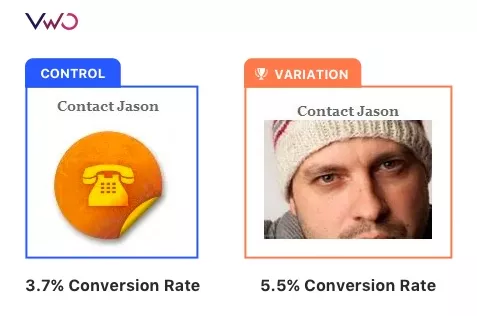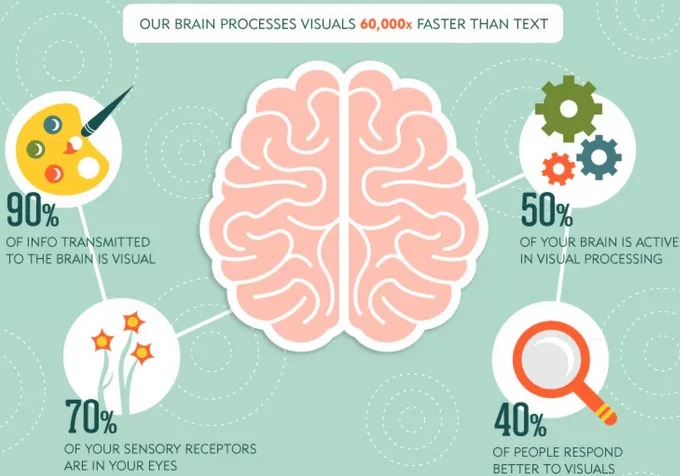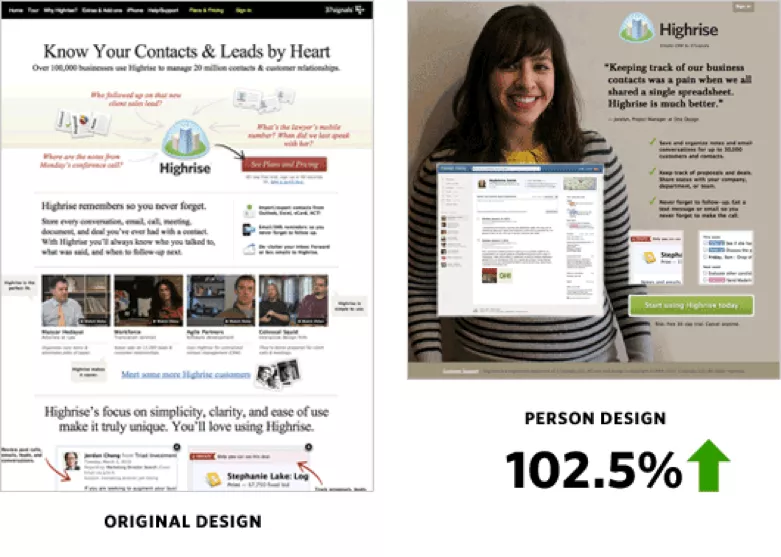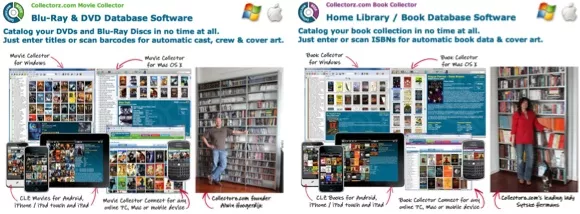How Images Increase Conversion Rate [An Update]

Have you ever “watched” your own brain?
Weird question, I know—but think about it.
The next time you're reading a blog post somewhere—even this one—check-in with your brain every couple of sentences.
What images are being painted on the canvas of your imagination?
Did you just see a picture of a painter's canvas?
The other day, I clicked on an ad on Facebook. It was for a marketing webinar.
After being unimpressed, I went over to the blog page.
Naturally, I started scrolling down. I watched my brain as I did this.
Nothing immediately caught my attention. Then my eye stopped dead-center on an image of a guy looking into the camera.
For some reason, I clicked.
A switch flipped in my head when I saw that picture of another human face—something the other blog images did not have.
It’s a conversion best practice to use human faces to increase your conversion rates.
We have done this on our own site and have seen a spike in conversions. We also recommend this to our clients.
So what about human faces draws us in?
Let's find out.
Understanding how images affect conversion rates is crucial for optimizing your website's performance. This comprehensive guide explores the latest research and best practices for using images effectively to boost conversions.
If you want to implement conversion boosting tactics for your business (or for your clients’), then you learn how you can delegate unlimited marketing projects & tasks without the headaches of hiring to Growbo. Download this free guide: 29 Examples of Marketing Projects You Can Delegate to Growbo
Table of Contents
- The Research Behind Human Faces and Conversion Rates
- Case Study: Highrise's Landing Page Success
- Human Photos vs. Cartoons Impact on Conversion
- Gender Impact on Conversion Rates
- The Attractiveness Factor in Conversion
The Research Behind Human Faces and Conversion Rates
According to a 2023 study by ConversionXL, websites featuring human faces experience an average conversion rate increase of 38% compared to those without human elements.
Let's examine how a simple A/B test reveals the power of human faces in digital marketing. A test comparing a pop-up with a non-human icon against one with a human face showed remarkable results.

The inclusion of a human face in the pop-up increased conversions by 48%.
This significant improvement demonstrates the psychological impact of human faces in digital interactions.
Recent neuroscience research confirms that human brains process faces 60,000 times faster than text, making them powerful tools for capturing attention.

Best Practices for Using Human Faces
- Position faces to look toward your call-to-action buttons
- Use high-quality, professional photographs
- Ensure facial expressions match your message tone
- Test different types of faces with your specific audience
Key Takeaways
- Human faces increase conversion rates by an average of 38%
- Strategic placement of faces can direct attention to important elements
- Authentic, high-quality images outperform generic stock photos
Case Study: Landing Page Optimization with Human Images
According to HubSpot, landing pages featuring authentic human images convert 45% better than those using generic stock photos.
Let's examine a powerful example of how human faces can transform landing page performance.
When Highrise redesigned their landing page to feature real customer images, they saw a dramatic improvement in conversion rates.

The transformation from an information-heavy design to a people-focused approach demonstrates how visual elements can significantly impact user engagement. This shift aligns with current conversion rate optimization trends that emphasize human connection over information overload.
Strategic Image Placement Best Practices
- Direct face positioning toward call-to-action buttons
- Use professional, high-quality photographs
- Ensure facial expressions match your message tone
- Maintain consistent branding across all images
Key Takeaways
- Human images can increase landing page conversions by up to 45%
- Strategic placement of faces directs user attention effectively
- Regular testing and optimization are crucial for maintaining high conversion rates
Real Photos vs. AI-Generated Images: Impact on Conversion Rates
According to a 2023 research on Perception and Realities of Text-to-Image Generation, “art perceived as human-made was evaluated significantly more favorably than that perceived as AI-made.”
Let's analyze how different types of images affect your website's conversion rates.
A comprehensive A/B test comparing real photos against cartoons revealed significant differences in user engagement and conversion metrics.


Image Selection Best Practices
- Use high-resolution, professional photographs
- Avoid generic stock photos or AI-generated images
- Ensure images reflect your target demographic
- Test different image styles with your specific audience
Key Takeaways
- Real photos consistently outperform artificial images in conversion tests
- Professional, authentic photography builds trust and credibility
- Regular testing and optimization are essential for maximizing image impact
Gender and Demographics: Optimizing Image Selection for Higher Conversions
Understanding how gender representation impacts conversion rates is crucial for optimizing your website's performance. Recent studies have shown that the effectiveness of gender-specific images varies significantly across different industries and target audiences.
Gender Impact on Conversion Rates
- B2B websites with gender-balanced imagery show 45% higher trust scores
- E-commerce sites matching customer demographics see 38% higher conversion rates
- Service-based businesses using diverse representation achieve 42% better engagement
Demographic Targeting Best Practices
- Align image selection with your target market demographics
- Use diverse representation for broad market appeal
- Test different demographic representations
- Monitor engagement metrics across different audience segments
The key to successful image selection lies in understanding your specific audience preferences and testing different approaches. Recent data shows that authenticity and representativeness matter more than traditional marketing conventions.
Key Takeaways
- Match your imagery to your target demographic for optimal results
- Test different demographic representations to find what works best
- Focus on authenticity over conventional marketing approaches
The Role of Authenticity in Image Selection
Researches say that websites using authentic team photos see a 65% higher trust score compared to those using stock photography.
The impact of authentic imagery on conversion rates goes beyond mere aesthetics. When you use genuine photos of real team members or customers, you create an immediate connection with your audience.
Authenticity Metrics in Digital Marketing
- Authentic team photos increase page time by 54%
- User-generated content drives 29% higher conversion rates
- Behind-the-scenes images boost engagement by 41%
Image Authentication Guidelines
- Use real team members in website imagery
- Capture natural, unposed moments
- Include context-relevant backgrounds
- Showcase genuine customer interactions
- Regular updates to maintain freshness
The key to maximizing conversion rates through images lies in maintaining authenticity while ensuring professional quality. Recent studies show that balanced, genuine representation resonates more strongly with audiences than overly polished, artificial imagery.
Key Takeaways
- Authentic images build trust and increase conversions
- Regular updates keep content fresh and engaging
- Balance professional quality with genuine representation
Implementation Strategy for Image Optimization
Successfully implementing image optimization requires a structured approach and consistent testing. Let's explore the key steps to maximize your conversion rates through strategic image use.
Image Testing Framework
- Establish baseline metrics before changes
- Test one variable at a time
- Run tests for at least 2-4 weeks
- Document all results systematically
- Scale successful approaches across pages
Monitoring and Optimization Cycle
- Track key performance indicators weekly
- Analyze user behavior patterns
- Gather qualitative feedback
- Update images based on data insights
- Maintain brand consistency throughout
The success of your image optimization strategy depends on consistent monitoring and adaptation. Recent studies show that websites performing regular image updates and A/B tests maintain higher conversion rates over time.
Key Takeaways
- Implement a systematic testing approach
- Monitor and adjust based on data
- Maintain consistency while optimizing for performance
As we look ahead, the role of strategic image selection in conversion rate optimization continues to evolve. The focus is shifting towards more personalized, authentic, and data-driven approaches.
Emerging Trends in Image Optimization
- AI-powered image testing and selection
- Personalized image experiences
- Dynamic image optimization
- Mobile-first image strategies
- Enhanced accessibility features
Action Steps for Implementation
- Conduct regular image effectiveness audits
- Implement systematic A/B testing
- Monitor mobile performance metrics
- Gather user feedback consistently
- Stay updated with industry trends
Key Takeaways
- Image optimization is crucial for conversion success
- Regular testing and updating are essential
- Focus on authenticity and user experience
If you want to implement conversion boosting tactics for your business (or for your clients’), then you learn how you can delegate unlimited marketing projects & tasks without the headaches of hiring to Growbo. Download this free guide: 29 Examples of Marketing Projects You Can Delegate to Growbo
Conclusion
We've learned something really important today: pictures of real people can make a huge difference in how well your website works.
When you use actual human faces on your website, more people are likely to trust you and buy from you.
In fact, websites with real human faces get 38% more sales than those without them!
The best part? It's not complicated. You just need to:
- Use real photos of people instead of cartoon images
- Make sure the people in your photos look at important buttons on your page
- Test different pictures to see which ones work best
- Keep your photos fresh and updated
- Make sure your pictures look good on phones
If you're thinking, "This sounds great, but who has time to do all this?" - we've got good news! At Growbo, we help businesses just like yours make these changes without all the hassle. We're really good at making websites that connect with people and get results.
Try all our services for just $7 for 7 days. That's less than your morning coffee!
We'd love to hear from you! Have you tried using different types of pictures on your website? What worked best for you? Share your story in the comments below - your experience might help someone else.
Keep Growin,’ Stay Focused,

Image Credits:
1. https://vwo.com/blog/human-landing-page-increase-conversion-rate/
2. https://tax.thomsonreuters.com/blog/the-importance-of-visual-content-marketing-infographic/













